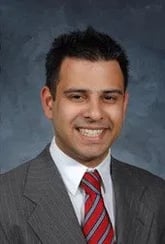Lung cancer is the deadliest cancer in the United States. In Colorado more than 2,500 people will be diagnosed with the disease and more than 1,400 will die of it in 2020. While advances in lung cancer treatment have gifted many patients with more time, the benefit of these treatments is limited by the racial and socioeconomic status of some patients in Colorado. A new study at the University of Colorado Cancer Center focuses on reducing disparities in lung cancer patients with diverse backgrounds.
Tejas Patil, MD
“Underrepresented patients with lung cancer may not be receiving the benefits that are coming out of the latest research,” says Tejas Patil, MD, CU Cancer Center member and principal investigator on the study. “Our goal is to ensure advances in treatment and care impact everyone.”
This study is being funded by the CU Cancer Center for investigators to work closely with the Office of Community Outreach and Engagement (COE). The goal of this office is to identify and address barriers to cancer health equality and improve outcomes of the underserved areas in Colorado.
“The COE will be working with Dr. Patil’s team to develop community-engagement strategies to ensure the appropriate representation of disadvantaged populations in the study. Currently, the population of patients of diverse backgrounds may not reflect the diversity needed to properly investigate lung cancer disparities,” says Evelinn Borrayo, Ph.D., Associate Director of the COE office. “The CU Cancer Center’s strategic goals include reducing cancer disparities in our catchment (the State of Colorado). Locally, Hispanic populations have significantly higher incidence and mortality from lung cancer than other Hispanics around the county, making such disparity a priority for our cancer center.”
This work will be done with the help of computer programmers and biostatisticians, researchers at the CU Cancer Center will create a database that captures important information from patients. In the future, this information will help physicians and scientists better understand how a patient may respond to certain treatments despite their racial or socioeconomic status.
“We will use our current resources and expertise to build a framework that can study precision medicine treatment outcomes in patients with diverse backgrounds and investigate potential local and systemic biomarkers that associate with these outcomes,” explains Patil. “Specifically, we intend to build a large, expansive and granular electronic database that will capture detailed information such as sex, race, ethnicity, medical comorbidities, insurance status and palliative care utilization. This database will link to clinical pathology samples, molecular testing results and treatment outcomes.”
Evelinn Borrayo, Ph.D.
Very basically, Dr. Patil and his team are working on creating a database that will contain specific information about patients, such as their sex, race, ethnicity, medical comorbidities, insurance status and use of palliative care. Analyzing information from the database will help doctors better understand which therapies may have the best response, as well as any potential side-effects in their patients that may vary based on individuals’ racial or socioeconomic status backgrounds.
“Despite important advances in the management of lung cancer, personalized therapy for lung cancer is not universally applied to patients based on race, age and socioeconomic status,” says Patil. “Additionally, the clinical trials that established these therapies as the standard of care have confined diversity in patient characteristics such as race, age and socioeconomic status.”
Precision medicine works by targeting a specific mutation in a patient with cancer. This type of treatment can be incredibly effective in managing the disease and adding years of quality life. Due to limited representation in clinical trials of the drugs, there is very little information about predictive biomarkers, negative side-effects or how well the drugs work in patients with diverse backgrounds.
“These disparities limit the benefit that patients of diverse backgrounds receive from precision medicine for lung cancer,” says Patil. “These disparities can have an incredibly negative impact for those patients. For example, potentially losing years of life that they could have had with precision medicine.”
Looking towards the future, the goal is for all patients with lung cancer to benefit from personalized therapy.
“Through this collaboration, we will be forming a foundation that can address potential socioeconomic and racial disparities all the way down to the molecular level,” says Patil.






